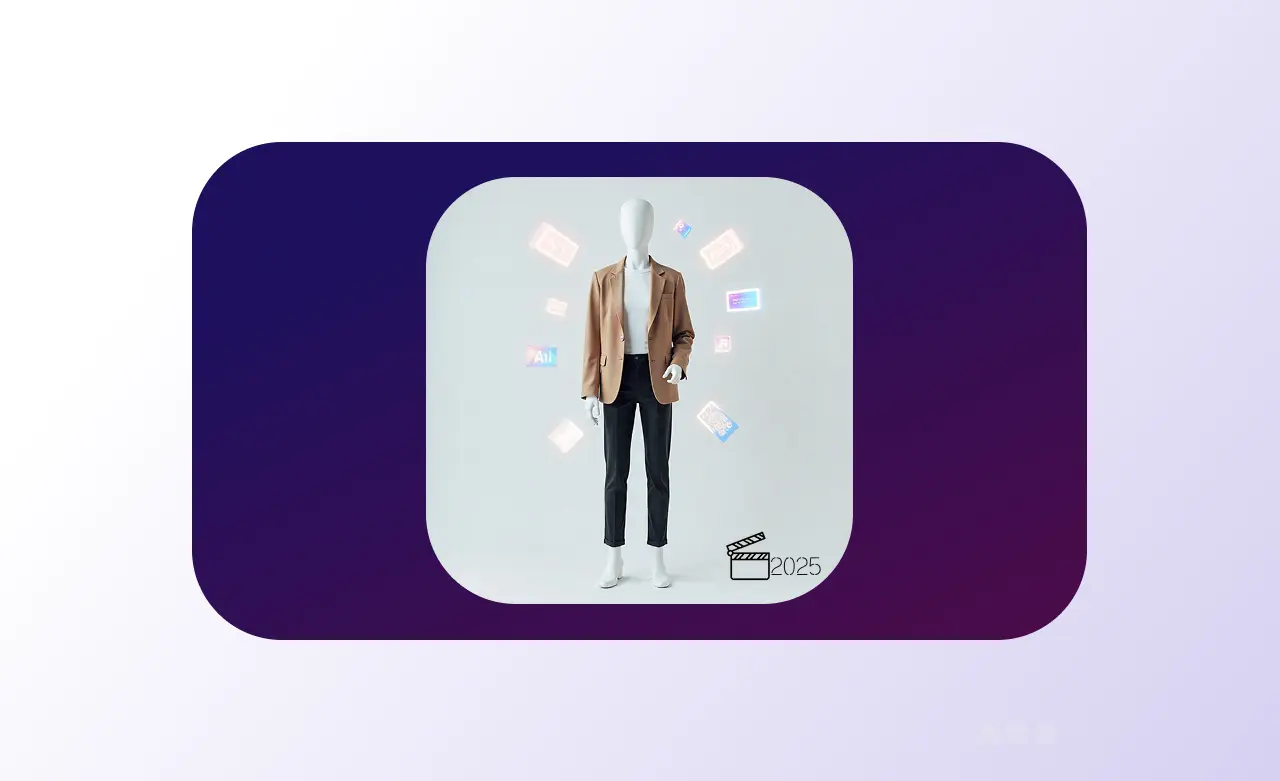Tag Your Way to Ecommerce Triumph: The Importance of Fashion Product Tagging

An eye-opening fact for you to start your read: an astonishing 75% of ecommerce shoppers say product photos influence their decision to buy the product. 75%! This means that if your ecommerce product catalog fails to provide rich results for what the shopper desires to buy, they will very likely leave and shop at some other site.
How can you make sure they stay and get lots of relevant info on their purchasing needs?
Two words: product tagging. It is 2023 and as the ecommerce sales are expected to account for 20.8% for retail sales worldwide by the end of this year, it's crucial for your fashion ecommerce site to stay technologically advanced and fulfill its promises to shoppers.
One of the essential steps to achieve this goal is to implement automated product tagging, a critical component of product tagging ecommerce. By doing so, you can unlock your ecommerce store's full potential, saving time, improving accuracy, and reducing operating costs. The benefits of product tagging for ecommerce are truly invaluable as it enhances customer retention and drives company growth.
Let’s explore how important fashion ecommerce product tags are and how they help your business.
Here is what you are going to read below:
- What is product tagging for ecommerce and how does it work?
- Why must brands and retailers do product tagging?
- How does product tagging actually work?
- Why is product tagging important for ecommerce?
- What are the challenges of product tagging?
- The solution: Automated Product Tagging
- How can AI help with product tagging?
- Best Practices for Ecommerce Product Tagging
- Why should Automated Product tagging be your choice?
- Conclusion
- FAQ
What is product tagging for ecommerce and how does it work?
So, here is the process of ecommerce product tagging explained as simple as possible. Product tagging is a pivotal process where we add important information (metadata) to the products using tags or labels. These ecommerce product tags help categorize and organize the products effectively within the inventory, forming a structured ecommerce product taxonomy that simplifies product discovery and navigation.
By creating and managing these labels, which play a crucial role in fashion product attribution, we can describe each product in a way that makes it easier for retailers to find and position the products correctly. This ensures a streamlined and efficient inventory management system.
Why must brands and retailers do product tagging?
It’s very simple: because by implementing product tagging they put the focus on creating excellent shopping journeys. In fact, these journeys should be tailored to meet the specific desires and requirements of shoppers, ensuring a seamless and satisfying experience for them.
How does product tagging actually work?
Product tagging in fashion ecommerce means adding descriptive labels to products based on attributes like style, color, and material. For example, tagging a summer dress with "floral pattern," "blue color," and "cotton material" helps customers find it easily, and enables personalized recommendations for similar items.
For instance, let's say you have a new summer dress that you want to add to your online store. First, you would create a product entry for this dress in your backend system. This entry would include details like the dress's name, description, price, color, size options, and images.
Next, you would create tags or labels for this dress based on its attributes. These tags could include information like "summer dress," "floral pattern," "cotton material," "blue color," and "available in sizes S, M, and L." These tags help categorize and describe the product effectively.
Once the tags are assigned to the dress, they become part of the dress's metadata. When a customer visits your website and searches for "summer dresses" or "blue dresses," the product tagging system will use these tags to match the customer's query with relevant products in your inventory. This allows the customer to easily find the specific dress they are looking for.
What is even more interesting is that product tagging enables you to create personalized shopping experiences. For example, if a customer frequently purchases floral pattern clothing items, your system can use the "floral pattern" tag to recommend similar dresses to that customer, increasing the chances of making a successful sale.
Why is product tagging important for E-commerce?
Picture this: you're running a fantastic fashion ecommerce store in the booming world of online shopping and you are aware of the estimation that E-commerce sales are expected to grow 10.4% in 2023. But with the rapid growth of ecommerce, it's becoming a crowded marketplace. So, how does product tagging make you stand out from the competition and give your customers an unforgettable experience?
Find products quickly and easily
Think about it: when a shopper comes to your website looking for that perfect summer dress, they want to find it quickly and easily. And with spot-on product tagging, you make their dreams come true. These tags help your products appear in search engines, advertisements, and social media platforms, making it a breeze for potential customers to discover your fabulous collection.
Okay, so you might say that we’ve discussed this, a paragraph above. And you want to know how this ties up with importance as a value? Well, here is how.
Personalized product recommendations
Product tagging isn't just about making your products visible; it's about understanding your customers on a whole new level. By analyzing the tags and attributes they prefer, you can offer personalized product recommendations that'll blow their minds. It's like having a personal shopper right at their fingertips.
Smooth flow of operation
And let's not forget the nitty-gritty stuff. Accurate product tagging ensures you stay on top of your inventory and sales, making it easier to manage your stock and keep your business running like a well-oiled machine.
Powerful marketing weapon
Here's the best part: when you tag your products right, it's not just a behind-the-scenes tool. It becomes a powerful marketing weapon that puts your brand front and center. With the right tags in place, you boost your online visibility, track your sales like a pro, and sell products like hotcakes.
What are the challenges of product tagging?
Every rose has its thorns, though, as an old proverb says. Even though the benefits of product tagging are numerous, there are still several challenges that brands and retailers face. Below are the common pitfalls and issues faced during the product tagging process.
- Time-consuming and hard to scale
Time, time, time! It's a precious commodity, and manual tagging can gobble it up like nobody's business. With tons of products, including those from third-party partners, tagging becomes a never-ending story. Wouldn't it be nice to spend that time on other cool stuff for your business?
- Costly
Cha-ching! Yeah, manual tagging can also hit you where it hurts - in the wallet. As your product line grows, you may need to hire extra help to keep up. But here's the kicker: it's not a one-and-done deal. No, you'll always need more hands on deck as things change and new products roll in.
- Inconsistent and incomplete
Syncing and matching, oh my! Wrangling different product categories, styles, models, and attributes from various sources is like herding cats. And let's face it, we all need a little help with matching synonyms and search-friendly terms. Inconsistent tags can cost you sales and opportunities.
- Labor intensive & error-prone
We all make mistakes, right? But when you're manually tagging thousands of products, the risk of errors goes through the roof. You don't want your customers searching for "cozy sweater" and ending up with a "crazy sweater" - that's a fashion disaster waiting to happen!
- Difficulty in tagging
Tagging a large product line, especially one with thousands of items, can be a complex task. As your product line changes and grows, your tags need some love too. Regular updates are a must to keep everything fresh and relevant.
The Solution: Automated Product Tagging
AI, particularly visual AI, computer vision or AI for targeted tagging, comes to the rescue as a powerful tool to conquer the hurdles of product tagging. By leveraging AI technologies, brands and retailers can revolutionize their previous manual tagging processes and enhance the overall customer experience.
How can AI help with product tagging?
Visual AI has the ability to analyze product images, identifying the unique attributes that define each item. Through automatic product tagging, AI breaks down the elements within an image, categorizes them, and assigns relevant metadata. This means that a single image of a leather jacket can be automatically tagged with descriptors like "silver hardware," "red lining," and "casual style," creating a more detailed and comprehensive item description.
And guess what? AI doesn't dawdle like us humans. It can tag massive inventories in no time, ensuring consistency throughout your catalog. And as new products come in, AI tags them instantly, keeping everything up-to-date in real-time.
See our fantastic AI tool in action. Get your Pixyle demo here.
Best practices for eCommerce Product Tagging
When it comes to product tagging for your eCommerce site, there are some tried-and-true best practices that can ensure accuracy and consistency. Let's take a look at the top tips to make your online shopping experience a hit:
- Use descriptive and keyword-rich tags
Tag your products with clear and relevant keywords. This helps improve search results and enhances the overall customer experience.
- Keep it short and sweet
Keep your tags concise and to the point. Avoid long and complicated tags that might confuse shoppers.
- Tag different product variations separately
If you offer different variations of a product, such as different colors or sizes, make sure to use distinct tags for each variation. This helps customers find exactly what they're looking for.
- Organize your tags into categories
Group similar tags into categories to make it easier for customers to navigate and find products based on specific attributes.
- Regularly update your tags
Keep your e-commerce product tags up-to-date as your inventory changes. This ensures that customers always get accurate and relevant information.
Why should Automated Product tagging be your choice?
Now, let's dive into the magic of AI-powered automated product tagging, which can take your eCommerce game to the next level:
Accelerate product placement process
Manually tagging thousands of products can be a real chore, but ai tags can speed up the process significantly. Within minutes, you can assign high-quality tags and update your catalog effortlessly.
Improve customer journey and experience
Automated product catalogs with top-notch tags and enticing descriptions create a great first impression for shoppers, leading to high converting product pages. This improved experience leads to higher conversion rates.
Enhance visual content
AI-powered product tagging not only speeds up the process but also improves the visual attributes of products. With advanced image recognition and deep learning capabilities, AI can spot the differences based on visual characteristics, making product search more effective.
Turn visual content into a powerful tool
AI doesn't stop at tagging; it can also generate text descriptions from fashion images, reducing back-office work and increasing efficiency.
Improve search engine listings
Rich and relevant tags enhance the searchability of your products online. When customers search for specific attributes, properly tagged products are more likely to appear in the results, leading to higher chances of conversions.
By implementing these best practices and harnessing the power of AI for automated product tagging, you can boost your eCommerce game, impress your customers, and create a delightful shopping experience for all!
To sum up
In conclusion, automated product tagging is crucial for fashion ecommerce success. It streamlines inventory, improves the customer experience, and boosts sales through personalized recommendations. AI-powered tagging offers a scalable and efficient solution, optimizing visual content and enhancing search engine visibility. By embracing this technology, businesses can thrive in the competitive online marketplace.
To sum up, automated product tagging is a game-changer for fashion ecommerce. It ensures seamless inventory management, delights customers with personalized experiences, and maximizes online visibility through AI-driven efficiency. By embracing this cutting-edge approach, businesses can stand out and excel in the dynamic world of online shopping.
FAQ
What is automated product tagging, and why do I need it for my fashion ecommerce store?
Automated product tagging is a process where AI technology analyzes product images and assigns relevant descriptive labels based on attributes like style, color, and material. It streamlines inventory management and helps customers find products quickly and easily. You need automated product tagging to enhance the customer experience, provide personalized product recommendations, and improve your online visibility, all while saving time and reducing manual errors.
How does automated product tagging benefit my fashion ecommerce business?
Automated product tagging offers several benefits for your fashion ecommerce store. Firstly, it accelerates the product placement process, enabling you to tag thousands of items within minutes. Secondly, it improves the customer journey by providing accurate and enticing product descriptions. Thirdly, AI-powered tagging enhances visual content and boosts your search engine rankings, making it easier for customers to discover your products. Finally, it turns visual content into a powerful marketing tool, generating text descriptions from fashion images and increasing efficiency.
Will automated product tagging work for my unique product catalog with various attributes and styles?
Absolutely! Automated product tagging using visual AI technology is designed to handle diverse product catalogs with various attributes and styles. The AI algorithms can recognize and categorize different product variations, ensuring that each item is appropriately tagged with its unique attributes. Whether you offer different colors, sizes, or styles, the AI can effectively handle the complexity and deliver accurate results.
How does automated product tagging compare to manual tagging in terms of accuracy and scalability?
Automated product tagging outperforms manual tagging in both accuracy and scalability. AI algorithms have been trained on massive datasets, enabling them to identify and tag attributes with high precision. This reduces the chances of errors commonly associated with manual tagging. Moreover, automated tagging can handle large product catalogs and new items effortlessly, making it highly scalable compared to the time-consuming and resource-intensive nature of manual tagging.
Can automated product tagging adapt to changes in my product inventory over time?
Yes, one of the key strengths of automated product tagging is its ability to adapt to changes in your product inventory. As your product line grows and evolves, the AI-powered tagging system can instantly update tags for new items and adjust to modifications in existing products. This ensures that your product catalog remains accurate, relevant, and up-to-date in real-time, providing a seamless shopping experience for your customers.
Discover Pixyle Ultimate Dress type Taxonomy Guide
Learn how to structure your catalog in a way that matches how people actually shop.


Boost your sales with AI product tagging
Optimize your eCommerce catalog to improve discovery and conversions.







